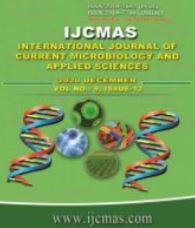


 National Academy of Agricultural Sciences (NAAS)
National Academy of Agricultural Sciences (NAAS)

|
PRINT ISSN : 2319-7692
Online ISSN : 2319-7706 Issues : 12 per year Publisher : Excellent Publishers Email : editorijcmas@gmail.com / submit@ijcmas.com Editor-in-chief: Dr.M.Prakash Index Copernicus ICV 2018: 95.39 NAAS RATING 2020: 5.38 |
In the present investigation, twenty-two Trichoderma isolates collected from different sources, along with one commercial isolate (Trichoderma viride) were screened for the antagonistic efficacy against soil borne plant pathogens viz., Fusarium oxysporum f. sp. vasinfectum, Rhizoctonia solani, Sclerotium rolfsii, and Phytophthora capsici. The result indicated that all twenty-two Trichoderma isolates effectively inhibited the mycelia growth at varied levels. Highest mycelial growth inhibition of F. oxysporum f. sp. Vasinfectum was recorded by RKd-Cu (97.44%) which was obtained from rhizosphere of cucumber. PSV and RMy-B isolates showed 100 per cent mycelial growth inhibition of R. solani, which was obtained from paddy straw and soil rhizosphere of banana crop respectively. RSr-Sc showed highest mycelial growth inhibition of two pathogens: S. rolfsii (95.19%) and P. capsici (96.25%). Whereas, the commercial isolate recorded growth inhibition of 72.59% (F.oxysporum f. sp. vasinfectum), 72.33% (R.solani), 72.48% (S.rolfsii) and 81.08% (P.capsici), which was significantly low compared to other isolates. Least Per cent of growth inhibition were recorded with RMl-T (72.59%), RKd-HG (72.22%), RD-A (66.70%) and RMy-SC (75.83%) against F. oxysporum f. sp. vasinfectum, R. solani, S. rolfsii and P. capsici respectively. Thus, from this study it can be concluded that effective isolates obtained from different geographical location have the better antagonistic activity than the commercial isolate against the soil borne fungal plant pathogens.
 |
 |
 |
 |
 |